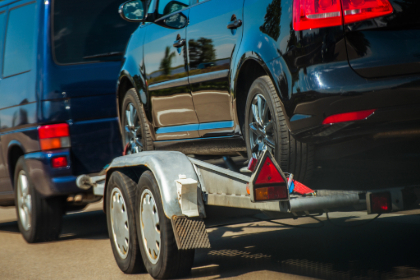INDEPENDENT DEALER
Zachary, LA | (225) 938-1686
OUR BLOG
Towing in the summer heat? Avoid breakdowns with these Louisiana summer towing tips from Tiger Synthetics in Zachary, LA! Stay cool & haul safer with AMSOIL.

Don’t let the Louisiana summer heat ruin your towing experience! Give your truck and trailer the best protection available with AMSOIL synthetic lubricants. Head over to the AMSOIL website to explore the best products for summer towing, or contact Tiger Synthetics in Zachary, LA, at (225) 938-1686 to order directly from an authorized AMSOIL dealer!
Towing in Louisiana’s scorching summer heat can stress your truck, trailer, and towing components. Whether hauling a boat to the Gulf, pulling a camper for a road trip, or using a work truck to tow heavy equipment, high temperatures and heavy loads demand top-tier lubrication and protection. Using AMSOIL synthetic lubricants is the key to keeping your vehicle and trailer running smoothly, preventing breakdowns, and ensuring a safer towing experience.
The Challenges of Summer Towing in Louisiana
Louisiana summers are no joke. With temperatures soaring into the high 90s and humidity making it feel even hotter, towing can become a real test of your vehicle’s endurance. Some of the most common summer towing problems include:
- Overheated transmissions due to heavy loads and prolonged travel
- Increased wear on gears and differentials from high stress and heat
- Brake and wheel bearing failures due to excessive friction
- Trailer hitch and coupling issues from a lack of proper lubrication
- Fuel inefficiency and power loss when hauling loads in extreme temperatures
The right synthetic lubricants can combat these issues. AMSOIL’s high-performance gear oils, transmission fluids, and grease are designed explicitly for towing in extreme conditions, making them perfect for Louisiana’s hot summers.
How AMSOIL Synthetic Lubricants Enhance Towing Performance
1. Keep Your Transmission Cool and Protected
Your transmission is the most vulnerable component when towing in extreme heat. Heavy loads force the transmission to work harder, and without proper lubrication, it can overheat and fail. AMSOIL Signature Series Multi-Vehicle 100% Synthetic Automatic Transmission Fluid is engineered to handle severe-duty towing. It offers:
- Superior heat resistance to prevent breakdown in high temperatures
- Enhanced oxidation control for longer-lasting protection
- Improved shift performance even under heavy loads
Considering Louisiana summer towing tips, switching to AMSOIL synthetic ATF ensures your truck maintains smooth shifting and reliable performance, even on the hottest days.
Towing heavy loads in Louisiana’s brutal summer heat? Ensure your vehicle stays cool and protected with AMSOIL synthetic lubricants! Shop now at the AMSOIL e-store or speak with a local AMSOIL dealer—call Tiger Synthetics in Zachary, LA, at (225) 938-1686 to order and get expert recommendations.
2. Protect Differentials and Gears with AMSOIL Synthetic Gear Oil
When towing, the added weight strains your truck’s differential, increasing heat and friction. Conventional gear oils break down faster in these conditions, leading to premature wear and potential failure. AMSOIL Severe Gear Synthetic Gear Oil provides:
- Extreme pressure protection for towing heavy loads
- Superior viscosity retention to withstand high heat
- Reduced friction to improve efficiency and longevity
Using AMSOIL synthetic gear oil for Louisiana summer towing tips ensures your differential stays properly lubricated, even when driving long distances in the brutal summer heat.
3. Extend Trailer Life with AMSOIL Synthetic Grease
Your trailer is just as important as your truck regarding safe and efficient towing. Wheel bearings, hitch components, and joints require proper lubrication to prevent wear, rust, and seizing. AMSOIL Synthetic Water-Resistant Grease is ideal for Louisiana’s humid climate because it:
- Repels water to prevent corrosion
- Handles extreme heat without breaking down
- Provides long-lasting lubrication for reduced maintenance
Applying AMSOIL synthetic grease to wheel bearings and hitch connections before a summer trip ensures smooth towing performance and helps avoid costly repairs.
Why AMSOIL Is the Best Choice for Louisiana Summer Towing
Unlike conventional lubricants, AMSOIL synthetic products are engineered to withstand extreme conditions without breaking down. With benefits such as:
- Higher heat resistance for Louisiana’s summer climate
- Superior wear protection for heavy-duty towing applications
- Longer-lasting performance to extend service intervals
Choosing AMSOIL gear oil, transmission fluid, and grease ensures your truck and trailer stay in peak condition, making every summer trip safer and more efficient. Whether you’re towing a boat, RV, or work equipment, AMSOIL products provide peace of mind and unmatched reliability on the road.
Final Thoughts: Stay Ahead of the Heat with AMSOIL
Keep these Louisiana summer towing tips in mind, perform regular maintenance, and invest in high-quality lubrication to keep your towing experience smooth and trouble-free all season long.